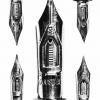Search the Community
Showing results for tags 'vintage vs modern flex'.
-
I got a used Pilot Justus 95 with a medium nib in the mail a few days back because I've wanted to try one for some time now. I've always been fascinated by the Doric's adjustable nibs, and now having a small collection of them in all their different sizes (except for #6 and #10) I was eager to compare the old, somewhat fragile Doric nib to the newer Justus nib. Now, there's the obvious difference between the two nibs in that the Doric is a fantastic example of vintage flexibility (my example of the #5 model is one of the wettest noodles to ever wet noodled) and the Justus is a soft modern nib (less flexible even than my cast of Pilot Falcons). And a quick but important aside: THIS IS NOT A THREAD COMPARING VINTAGE AND MODERN FLEX NIBS. Please don't devolve this thread into that trite bickering. This thread is about the philosophy, design, and usability of a nib that allows the adjustability of its line variation, regardless of the quality of the variation. The first time I inked up the Justus and tried out the faux overfeed doohickey I immediately noticed that there was very little difference between the feeling of writing in the "H" setting and the "S" setting. Both were very soft and offered very little feedback, like the suspension of a late 80s Town Car. When switching the settings on an old Doric the effect is immediate, day and night almost. But the Justus went from squishy ("S") to squishy with a slightly discernible bottom ("H"). And in terms of the line variation the Justus offers between the two extremes of its settings, I could immediately tell that there was very little of a difference between applying the same amount of pressure to each. So I decided to use a technique I've been using for vintage nibs for a while now: carbon copy paper. With carbon paper, the effects of different types of inks (wet, dry, feather-prone, etc.) and the wetness of the pen (whether it writes dry or is on the gushy side) is nil. All you see on the carbon copy is the direct line variation of the nib you're using. The advantage of bypassing the inks' quirks is invaluable for this comparison. So let's talk vintage first. I have four adjustable nib'd Dorics, sizes #3, #5, #7, and #9 (I'm missing #6 & #10). All of the sliding adjusters are of the hollow design (see pictures) rather than the solid design. With all four Dorics, the difference between max flexibility and max rigidity is staggering. Click the slider forward and you're writing with what nearly feels as solid as a nail. Click the slider all the way back and (depending on the individual nibs) you have a gorgeously responsive flex nib. Th two extremes are worlds apart. But with the Justus things are different. You twist the dial at the end of the section to switch between maximum flexibility (denoted by an "S" on the dial) and maximum stiffness (denoted by an "H" on the dial), which unfortunately feel nearly the same. There is more resistance on the "H" setting, but it only comes after you flex quite a bit. The only real effect the different modes have on the page is that script written with a heavy hand in the "H" setting is wetter than if you write the same thing with the same pressure in "S" mode. "S" mode does give you a bit more ink shading, but it also lets the feed run dry when you flex for more than a few words. In the end, I feel that the Pilot Justus' flexibility adjustments are about as effective as Delta's asinine Fusion nib. There's a slight difference in nib feel between the two modes, but on the page there's barely a difference. And to prove it, I used the aforementioned carbon paper. Pictures will be in the following posts.
- 10 replies
-
- pilot justus 95
- pilot adjustable nib
- (and 5 more)

